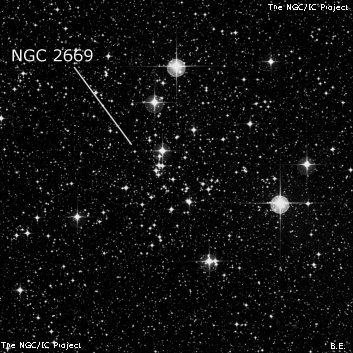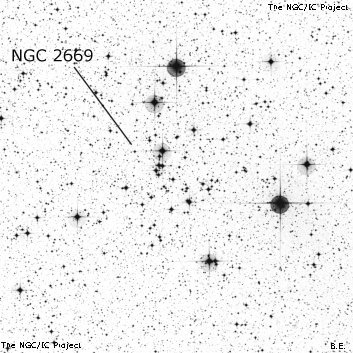NGC/IC Project Restoration Effort
(This is a very very beta version)
NGC2669


Basic Information
Location and Magnitude
Right Ascension: 8:46:19.0
Declination: -52:56:6
Constellation: VEL
Visual Magnitude: 6.1
Historic Information
Discoverer: Herschel J.
Year of discovery: 1834
Discovery aperture: 18.3
Observational
Summary description: Cl, L, P, lC, st 10…13
Sub-type: II3p
Corwin's Notes
=====
NGC 2669. There has been -- and continues to be -- some controversy about the
correct identification of this cluster.
JH didn't help much; his observation and description is sparce:
[h] 3140 8 40 +- 143 21 +- Cluster VII class. A L, poor, loose cl of
stars, 10....13m [Sweep] 440
Consulting the observing log gives us no more information than that; the RA
and NPD are still marked "+-", they are properly reduced, and the description
is copied correctly into the CGH. The GC, however, has no indication that the
position is approximate aside from having the "number of observations used"
marked "::". In particular, JH simply precessed the approximate position to
1860 and presented it with the tenths of seconds of time and arc in full view,
just as if it were a micrometric position measured on a superb night with a
state-of-the-art instrument and an expert observer. The only one of these
apparently present was the expert observer, perhaps rushed ... Dreyer simply
followed along, so the NGC has no clue at all that the position is simply an
approximation.
There the matter sat until Trumpler was searching for the cluster in the
early 1930s. He suggested an error of 1 degree in the declination and another
1 minute 40 seconds in RA, leading to Harvard 3, found sometime during the
1920s by Harlow Shapley and his Harvard team. Brent Archinal, in "Star
Clusters" has that whole story, and I can do no better than point you to that
discussion.
Brent's conclusion is, however, awkward in my opinion. He makes Harvard 3 the
core of NGC 2669, with the four 7-8 magnitude stars around it as members.
This is at odds with JH's estimate of the brightest cluster members being
magnitude 10. Even granting Brent's point that JH's magnitude scale could be
off, it was not THAT far off at the bright end. The position and diameters
that I give in the position table for Harvard 3 is only for the "core" of the
cluster. My feeling, without proof, is that the four brighter stars are
unrelated field stars. We can, of course, now check this with photometry and
proper motions.
Furthermore, there IS a scattering of 20-25 stars in the right magnitude range
centered just four arcminutes north of JH's position. I make the collection
12 by 8 arcminutes, and it looks exactly as JH describes it, "A large, poor,
loose cluster of stars, 10th to 13th magnitude." Even giving some credence to
Trumpler's idea, the cluster at JH's position is more in keeping with his
observation, crude as it is.
Finally, a side note. The NGC lists "[al] Sufi" as the original discoverer
of this cluster. This notion, from an 1874 study of al-Sufi's observations
by Schjellerup, is rejected by Glyn Jones in "The Search for the Nebulae"
where he correctly identifies al-Sufi's object as IC 2391 (which see). There
is no trace of IC 2391 in JH's CGH observations.
Steve's Notes
=====
NGC 2669
14" (4/3/16 - Coonabarabran, 142x and 184x): fairly rich group of ~60 stars in a 6' or 7' region, elongated N-S. Includes a mix of brighter mag 9.5-11 stars, along with a number of faint mag 14-15 stars. A mag 9.5 star and five mag 11-12 in a 1.5' N-S string, is on the northeast side. The cluster is bounded by a striking number of very bright stars including mag 7.6 HD 75105 off the southwest side, mag 8.2 HD 75227 and mag 7.7 HD 75202 off the north side, and mag 8.6 HD 75167 off the south side (20" pair with a mag 11 star). The group spans at least 12' to 14' if you include these bright stars. Located ~55' E of IC 2391 (surrounding mag 3.6 Omicron Velorum).



